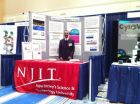(Press-News.org) PITTSBURGH— Nonchemical treatment systems are touted as environmentally conscious stand-ins for such chemicals as chlorine when it comes to cleaning the water-based air-conditioning systems found in many large buildings. But a recent study by University of Pittsburgh researchers suggests that this diverse class of water-treatment devices may be ineffective and can allow dangerous bacteria to flourish in the cooling systems of hospitals, commercial offices, and other water-cooled buildings almost as much as they do in untreated water.
The two-year study by a team in Pitt's Swanson School of Engineering is the first to thoroughly investigate the ability of nonchemical treatment devices (NCDs) to control the growth of bacteria in water-based cooling systems. Of the five NCDs tested, none significantly prevented bacterial growth. On the other hand, the researchers found that standard chlorine treatment controlled these organisms, even after bacteria had been allowed to proliferate.
"Our results suggest that equipment operators, building owners, and engineers should monitor systems that rely on NCDs to control microorganisms," said coinvestigator Janet Stout, a research associate in the Swanson School's Department of Civil and Environmental Engineering and director of the Pittsburgh-based Special Pathogens Laboratory. Stout worked with fellow lead investigator Radisav Vidic, chair and William Kepler Whiteford Professor of civil and environmental engineering, and Pitt civil engineering graduate student Scott Duda.
"These cooling systems are energy efficient and, if properly treated, very safe," Stout continued. "But based on our results, nonchemical devices alone may not be enough to control microbial growth. One possible measure is to add chemical treatment as needed to prevent a potential health hazard."
The air systems the team investigated work by piping chilled water throughout a building. The water warms as it exchanges temperature with the surrounding air and becomes a hotbed of microorganisms before returning to a central cooling tower to be cleaned and re-chilled. If the returning water is not thoroughly cleaned, bacteria can spread throughout the system, exposing people within the building to possible infection and hampering the system's energy efficiency.
The team constructed two scale models of typical cooling towers. One model remained untreated while the other was treated with five commercially available NCDs installed according to the manufacturers' guidelines. Each device was tested for four weeks. Chlorine was administered three times during the study to demonstrate that an industry-accepted chemical treatment could kill bacteria even in a heavily contaminated system.
The five devices tested represent different classes of NCDs, Vidic said. Pulsed electric-field devices emit electromagnetic energy that, in theory, ruptures bacterial membranes and activates particles that ensnare the bacterium. Electrostatic devices function similarly by producing a constant static field.
Ultrasonic devices pass a mixture of untreated water and high-pressure air through a chamber that purportedly disintegrates the bacterium with sound waves. For hydrodynamic cavitation devices, two cone-shaped water streams collide to form a vacuum region filled with high-friction bubbles that collide with and presumably deactivate the bacteria. Finally, the team tested a magnetic device, although magnetic NCDs are intended to prevent mineral buildup, not control bacterial growth.
INFORMATION:
The study was funded by the American Society of Heating, Refrigerating, and Air-Conditioning Engineers.
Pitt study finds 'green' water treatments may not kill bacteria in large building cooling systems
5 devices pitched as alternatives to chemical water treatment for water-based air-conditioning systems allowed the same rate of bacterial growth as untreated water, Pitt researchers found in 2-year study
2010-12-11
ELSE PRESS RELEASES FROM THIS DATE:
Directed self-assembly of vertical nanotubes for biosensors, logic, nano-biofuel cells
2010-12-11
"Directed Self-Assembly of Vertical Nanotubes for Biosensors, Logic, and Nano-Biofuel Cells," will be the focus of NJIT's exhibit today
at the National Nanotechnology Innovation Summit 10 http://www.nsti.org/events/NNI/, at the Gaylord Center in Washington, DC. The event celebrates the 10th anniversary of the national nanotechnology initiative.
NJIT was the only university in New Jersey selected for this exposition featuring practical applications of nanoscience resulting from the last decade of federal funding under the National Nanotechnology Initiative (NNI). ...
Researchers establish new rule to predict risk of stroke, death from surgery that prevents it
2010-12-11
DALLAS – Dec. 10, 2010 – It's a medical Catch-22: carotid artery surgery can itself cause stroke, but so can asymptomatic carotid disease if left untreated.
UT Southwestern Medical Center researchers have now developed a clinical risk prediction rule using factors such as sex, race and health history to assess the danger the surgery poses, while a modified version will help patients make a more fully informed choice about whether to have the procedure.
"It may take a thief to catch a thief, but physicians don't want to cause stroke while trying to prevent stroke, so ...
A few steps could lead to big gains for hospitalized seniors
2010-12-11
GALVESTON, Texas — "You'll be back on your feet in no time" is a phrase familiar to anyone who's ever had to spend time in a hospital. Now, a new study has shown that hospitalized elderly patients who literally "get back on their feet" by taking even short walks around a hospital unit tend to leave the hospital sooner than their more sedentary peers.
Conducted at the University of Texas Medical Branch at Galveston and described in a paper appearing in the current issue of Archives of Internal Medicine, the study draws on data collected from 162 hospitalized patients over ...
UVic biomedical engineer 'outsmarts' HIV
2010-12-11
It is estimated that 38 million people worldwide are currently infected with HIV and that 4.1 million more are added each year. For scientists to design treatment therapies that are effective over the long-term it is essential to learn more about how the virus mutates and develops resistance to medications.
New, groundbreaking research by University of Victoria biomedical engineer Stephanie Willerth has significantly advanced the understanding of HIV and how to treat it.
"The virus mutates at a very high rate which is very problematic for HIV patients because the virus ...
Sign languages help us understand the nature of metaphors
2010-12-11
(Washington, DC) – A recent study of the use of metaphors in spoken language and various sign languages shows that certain types of metaphors are difficult to convey in sign language. The study, "Iconicity and metaphor: Constraints on metaphorical extension of iconic forms," to be published in the December 2010 issue of the scholarly journal Language, is authored by Irit Meir of the University of Haifa. A preprint version is available on line at:
http://lsadc.org/info/documents/2010/press-releases/meir.pdf.
Dr. Meir's research sheds new light on the interrelations between ...
News tips from the Quarterly Review of Biology
2010-12-11
The December issue of The Quarterly Review of Biology is now available. The issue features articles on the nature of individual organisms, evolution observed in the lab, play behavior across animal species, and a criticism of intelligent design creationism. Abstracts are available at http://www.journals.uchicago.edu/toc/qrb/current.
What is an Individual?
For organisms like fish, mice, and people, it's not hard to distinguish between individuals. However, for colonial creatures like corals and anemones, and for organisms like slime molds and bacteria, the line separating ...
Pacific Northwest National Laboratory's 2010 AGU tip sheet
2010-12-11
SAN FRANCISCO – Scientists from the Department of Energy's Pacific Northwest National Laboratory will present their research at the 2010 American Geophysical Union Fall Meeting, which runs Monday, Dec. 13 through Friday, Dec. 17 at the Moscone Convention Center in San Francisco.
SPLAT unearths complex view of airborne particles
Measuring individual particles instead of the average reveals a complex landscape
Climate researchers trying to characterize aerosol particles – tiny bits of organic molecules, sulfate, dust, soot and more – are limited to measuring averages, ...
Perfect Breath Authors Team with BreathSlim To Advance the Power of Breathing
2010-12-11
Alfred Lee and Don Campbell, authors of the internationally acclaimed book, Perfect Breathing: Transform Your Life One Breath at a Time (Sterling Publishing/New York City), today announced that the makers of BreathSlim , a revolutionary new breathing device that trains users to breathe correctly to fully utilize the power of oxygen, will begin excerpting relevant sections of Perfect Breathing to help users better understand the tremendous impact mindful breathing has on health, well-being and performance.
"We are excited about the potential of teaming up to share these ...
Staff Virtual Accelerates Operational Efficiency with New Phone System
2010-12-11
Staff Virtual, a leading provider of Virtual Assistants (VAs), provisioning turnkey offshore team development, is pleased to announce new improvements to the company's phone system, and high-speed Internet connections located in our Manila, Philippines offices.
Staff Virtual's new phone system, powered by Enzu, is a flexible, cloud-based, multi-extension business phone system with advanced voice and fax functionality, always-on digital-line service, unlimited calling and full-featured phones that arrive pre-configured and ready for use. Staff Virtual chose Enzu, an ...
BBB Gives Excellent Rating for TonerGreen.com
2010-12-11
TonerGreen, the online printer supplies store that produces eco-friendly, U.S.-made and non-patent infringing ink and laser toner cartridges, has just been given an excellent rating by Better Business Bureau, also known as BBB.
Better Business Bureau or BBB is a well-known organization that monitors and keeps records of every business that it grants accreditation. A business with a good rating or grade from BBB means that it has great products and customer service, assuring buyers that they are getting more than their money's worth. Furthermore, BBB makes sure that it ...
LAST 30 PRESS RELEASES:
School meals could unlock major gains for human and planetary health
Menopause hormone therapy does not appear to impact dementia risk
Signature patterns of brain activity may help predict recovery from traumatic brain injury
Dresden study uncovers new key mechanism in cancer cells
New species are now being discovered faster than ever before, study suggests
Cannabis-based products show limited short-term benefit for chronic pain, with increased risk of adverse effects
Cannabis products with more THC slightly reduce pain but cause more side effects
Clearing the brain of aging cells could aid epilepsy and reduce seizures
Brain injuries linked with potential risk of suicide, new study finds
New technique lights up where drugs go in the body, cell by cell
New study finds movement of fishing fleets can reveal shifts in marine ecosystems
Embargoed: New evidence points to potential treatment for vascular dementia
Study uncovers disrupted brain balance in alcohol dependence
Working in groups can help Republicans and Democrats agree on controversial content moderation online
Structural findings reveal how distinct GPCR ligands create different levels of activation
Anything-goes “anyons” may be at the root of surprising quantum experiments
UC review: Maximizing workplace opportunity for veterans
From generation to complex control: Metasurfaces make perfect vortex beams "within reach"
Thin-film lithium niobate-based detector: recent advances and perspectives
Exploring why some people may tend to persistently make bad choices
How cells balance their protein levels
Nirsevimab vs RSVpreF vaccine for RSV–related hospitalization in newborns
Effectiveness and impact of maternal RSV immunization and nirsevimab on medically attended RSV in US children
AI gives scientists a boost, but at the cost of too many mediocre papers
Next-generation vision model maps tree growth at sub-meter precision
Genes aren’t destiny for inherited blindness, study shows
MIT study: High-fat diets make liver cells more likely to become cancerous
Exposure to multiple fine particulate matter components and incident depression in the US Medicare population
Risk of burdensome health care spending over time in the US
Nirsevimab against hospitalizations and emergency department visits for lower respiratory tract infection in infants
[Press-News.org] Pitt study finds 'green' water treatments may not kill bacteria in large building cooling systems5 devices pitched as alternatives to chemical water treatment for water-based air-conditioning systems allowed the same rate of bacterial growth as untreated water, Pitt researchers found in 2-year study

